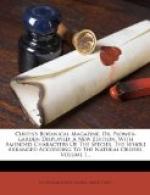Specific Character and Synonyms.
ALYSSUM utriculatum caule herbaceo erecto,
foliis laevibus lanceolatis
integerrimis,
filiculis inflatis. Linn. Syst. Veget.
ed. 14.
Murr.
ALYSSOIDES fruticosum, leucoji folio viridi. Tourn. inst. 218.
[Illustration: No 130]
A native of the Levant, and cultivated by Mr. MILLER in the year 1739.
Is a hardy and beautiful perennial, flowering from April to June, at which time it begins to form its curiously inflated pods.
Like the Alyssum deltoideum, it is well adapted to the decorating of walls, or rock-work, and is readily propagated either by seeds or slips.
[131]
CATESBAEA SPINOSA. THORNY CATESBAEA, or LILY-THORN.
Class and Order.
TETRANDRIA MONOGYNIA.
Generic Character.
Cor. 1-petala, infundibuliformis, longissima, supera. Stamina intra faucem. Bacca polysperma.
Specific Character and Synonyms.
CATESBAEA spinosa. Linn. Syst.
Vegetab, ed. 14. Murr. p. 152. Sp.
Pl. p. 159.
Ait. Hort. Kew. p. 159.
Frutex spinosus, buxi foliis plurimis simul nascentibus,
flore
tetrapetaloide
pendulo sordide flavo, tubo longissimo, fructu
ovali croceo semina
parva continente. Catesb. Carol. 2. p. 100.
t. 100.
[Illustration: No 131]
Of this genus there is only one species described by authors, and which LINNAEUS has named in honour of our countryman MARK CATESBY, Author of the Natural History of Carolina.
“This shrub was discovered by Mr. CATESBY, near Nassau-town, in the Island of Providence, where he saw two of them growing, which were all he ever saw; from these he gathered the seeds and brought them to England.
“It is propagated by seeds, which must be procured from the country where it naturally grows. If the entire fruit are brought over in sand, the seeds will be better preserved; the seeds must be sown in small pots filled with light sandy earth, and plunged into a moderate hot-bed of Tanner’s-bark. If the seeds are good, the plants will appear in about six weeks; these plants make little progress for four or five years. If the nights should prove cold the glasses must be covered with mats every evening. As these plants grow slowly, so they will not require to be removed out of the seed-pots the first year, but in the Autumn the pots should be removed into the stove, and plunged into the tan-bed; in spring the plants should be carefully taken up, and each planted in a separate small pot, filled with light sandy earth, and plunged into a fresh hot-bed of Tanner’s-bark. In Summer when the weather is warm, they should have a good share of air admitted to them, but in Autumn must be removed into the stove; where they should constantly remain, and must be treated afterwards in the same manner as other tender exotic plants.” Miller’s Dict.




